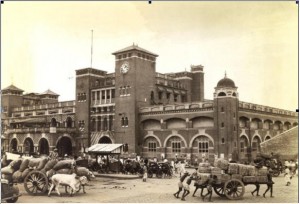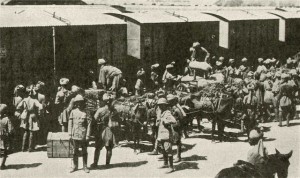Sisir Sarbadhikari § moved into the Bengal Ambulance Corps barracks, at Alipore, on April 1st 1915. The volunteers’ training was completed in three months at the end of which its total strength was 117: it was led by five British officers – a Colonel and four lieutenants. For the rest there were 72 NCOs and privates, and 41 camp-followers (cooks, bhisties, sweepers etc).
Sisir and the other volunteers left by train

from Calcutta’s Howrah Station on 26th June and reached Bombay on June 28th.
On June 30th the volunteers watched as the 6th Poona Division embarked at Alexandra Docks.

On the 30th heavily loaded ships left with Indian battalions. They were all Marathas. Some said they were going to Egypt, some said France. Their parents, wives and children came to see them off. Tears flowed! Slowly the ships began to move and the battalion bands struck up ‘Auld Lang Syne’. (12)
The Ambulance Corps left a couple of days later, on the Madras, a hospital ship.
At 9.30 am on July 2 the ship pulled away from the dock. It was just two days since the Marathas’ families had come to see them off – with copious tears. No one came to see us off but we were still pained by the thought that we were leaving our country. The surprising thing was that when we left Calcutta none of us were as sad as we were now. Amongst those who came to see off the Marathas there was an old man who wept as he asked his son if he would ever return to the country. Would we return either? But thoughts like these did not weigh on us much at that time. (13)

The Madras reached Basra
on July 9 and a couple of days later the BAC was sent upriver to Amara. They remained there for a month and a half before being sent northwards. On the 10th of October they reached Aziziya after a series of forced marches – but they were still well behind the front line.
It so happened that Capt. Kalyan Mukherji was marching with them part of the way and on Oct 10 he wrote a letter home:
32 lads from the Bengal Ambulance Corps marched with us with 5 stretchers. The poor fellows aren’t accustomed to this kind of thing and their eyes and noses were flowing. In the first place they have to put up with the dhamkaoings of the Sahib officers; then they have to associate with lowly doolie-bearers; nor is the food to their liking – and on top of that they have to march 20 miles a day. They’re in a bad way.
Most of them say ‘if we knew that it would be like this then which damn fellow would have volunteered? We thought we’d see a few battles, pour water on the lips of the wounded, tie bandages and show everyone how brave Bengalis are (they’re very enthusiastic about all of this) – but we haven’t even heard the sound of artillery, let alone do any of that; all we do is work as coolies, they’re going to kill us with these marches.’
Ever since they said they’d send a Bengal Ambulance Corps into service in the field, I knew that these kids had no idea what they were getting into. A daily 20 mile march and on top of that rationed water – they never even dreamt that it would be like this. But even then they’re willing to put up with it, so long as the officers don’t treat them as coolies.’[i]
Capt Mukherji probably had good reason for his rather harsh judgement of the BAC volunteers. Like millions of young men who were volunteering for the war, in Britain, France, Germany and elsewhere, Sisir and his comrades clearly had no idea of what they were getting themselves into; with barely three months training before being sent into the field, many of them may well have regretted joining up.
But in Capt. Mukherji’s tone there is also a touch of the professional’s scorn for the amateur, the career officers’ disdain for the short-service soldier. In fact it was Capt. Mukherji who was behind the times. This was not a war of professional soldiers – the great majority of the men who were drawn into it were, in fact, volunteers like Sisir.
But it would seem that Capt Mukherji soon changed his mind about the ‘kids’ – and they, for their part, would soon hear plenty of artillery.
The battle of Ctesiphon was fought on November 22, 1915, six weeks after Capt Mukherji wrote the letter above. On the retreat he met up again with Sisir and the other BAC volunteers.
Writing about this encounter, Sisir notes: Capt Puri was in command of our convoy. Capt Mukherji was with him; he had been injured and his arm was still in a sling. He told [Havildar] Champati that the officers had been all praise for the BAC during the battle of Ctesiphon. (45)
[§ The page references are to Abhi Le Baghdad [‘On To Baghdad’ by Sisir Sarbadhikari (Calcutta, 1958)]. The passages in colour are my own translations of excerpts from this text.]
[i] Kalyan Pradeep: Captain Kalyan Kumar Mukhopadhaya, I.M.S.-er Jiboni, by Mokkhoda Debi (1928) [‘Kalyan Pradeep: The Life of Captain Kalyan Kumar Mukherji, I.M.S.’]; pp 324-5.
